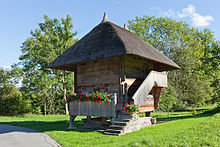Oberkulm
| Oberkulm | |
|---|---|
| State : |
|
| Canton : |
|
| District : | Kulm |
| BFS no. : | 4140 |
| Postal code : | 5727 |
| UN / LOCODE : | CH OBM |
| Coordinates : | 651 798 / 238988 |
| Height : | 480 m above sea level M. |
| Height range : | 462–757 m above sea level M. |
| Area : | 9.41 km² |
| Residents: | 2723 (December 31, 2019) |
| Population density : | 289 inhabitants per km² |
|
Proportion of foreigners : (residents without citizenship ) |
23.1% (December 31, 2019) |
| Website: | www.oberkulm.ch |
| Location of the municipality | |
Oberkulm ( Swiss German : ˈɔbərˌχʊlm ) is a municipality in the Swiss canton of Aargau . It belongs to the Kulm district and is located in the central Wynental .
geography
The village is a scattered settlement that stretches across the entire, almost one kilometer wide valley floor and has grown loosely together with the development of Unterkulm . The Wyna meanders in numerous turns along the western edge of the valley. The almost two kilometer long Tüetental branches off to the east. The 583 meter high Ischlag rises between the main and side valleys. This narrows to a narrow ridge and then merges into the Hohe Felsen ( 741 m above sea level ), which forms the border to the Seetal . The hamlet of Sod ( 630 m above sea level ) is located on the ridge . The western side of the Wynental valley is strongly fragmented and consists of several short side valleys and steep hills protruding in between.
The area of the municipality is 941 hectares , of which 341 hectares are forested and 114 hectares are built over. The highest point is at 735 meters just below the high rock, the deepest at 465 meters on the Wyna. Neighboring communities are Unterkulm in the northwest, Dürrenäsch in the northeast, Zetzwil in the southeast, Gontenschwil and Schmiedrued in the south and Schlossrued in the west.
history
The area was already settled during the Neolithic period between 5000 and 3800 years ago. In 1756, a landowner came across the remains of the wall of an extensive Roman manor that was inhabited from the 1st to the 4th century. The building was a portico villa with an attached bathroom. Most of the finds made at the time have now disappeared. Albrecht von Haller also took part in the excavations .
The place name developed from the Latin villa columbaria ("courtyard with dovecote"). The first documentary mention of Chulenbare took place in 1045 in a letter of protection, the Emperor Heinrich III. the Beromünster Abbey . In 1295 Obern Chulnbe was first explicitly distinguished. In the Middle Ages the village was under the rule of the Counts of Lenzburg , from 1173 on that of the Counts of Kyburg . After these died out, the Habsburgs took over sovereignty and blood jurisdiction in 1273 . The owners of the lower jurisdiction were the lords von Rued until 1369, the lords von Büttikon until 1428, the lords von Rüssegg until 1491, then the Herport family from Willisau .
In 1415 the confederates conquered Aargau. Oberkulm now belonged to the subject area of the city of Bern , the so-called Berner Aargau . After Bern had also acquired lower jurisdiction in 1517, Oberkulm formed part of the Kulm judicial district in the Lenzburg district . In 1528 the Bernese introduced the Reformation . Around the middle of the 18th century, cotton spinning and weaving established itself as home work . In March 1798 the French took Switzerland, ousted the «Gracious Lords» of Bern and proclaimed the Helvetic Republic . Since then, Oberkulm has been part of the canton of Aargau.
In contrast to the upper Wynental, the industry in Oberkulm arrived relatively late, around 1870. Between 1850 and 1920 the population fell by over a third. But even in earlier times, many impoverished families were forced to emigrate. Johann Heinrich Huber emigrated to the Palatinate in 1665, and his descendants continued to North America in 1738 . Herbert Hoover , who was President of the USA from 1929 to 1933, descends from these . The Wynentalbahn started operating on March 5, 1904. Oberkulm developed into an industrial center, while agriculture was increasingly pushed back. Since the early 1980s, the population has halved due to increased building activity.
Attractions
There is a thatched granary in the Obersteg area. It was built in 1540/50, renovated in 1960 and re-roofed in 1988; today it is a listed building. It is the oldest still existing building of its kind in Switzerland.
coat of arms
The blazon of the municipal coat of arms reads: "Split twice by black, white and blue." Up until 1953, Ober- and Unterkulm had the same coat of arms. The cantonal coat of arms commission was of the opinion that two municipalities should not have the same coat of arms. For this reason, the division was arranged vertically instead of horizontally.
population
The population developed as follows:
| year | 1764 | 1803 | 1850 | 1900 | 1930 | 1950 | 1960 | 1970 | 1980 | 1990 | 2000 | 2010 |
| Residents | 813 | 1200 | 1784 | 1331 | 1207 | 1522 | 1596 | 1774 | 1852 | 2188 | 2252 | 2441 |
On December 31, 2019, 2723 people lived in Oberkulm, the proportion of foreigners was 23.1%. In the 2015 census, 41.2% described themselves as Reformed and 17.2% as Roman Catholic ; 41.6% were non-denominational or of another faith. In the 2000 census, 89.4% stated German as their main language, 3.6% Turkish , 1.6% each Albanian and Serbo-Croatian and 1.4% Italian .
Politics and law
The assembly of those entitled to vote, the municipal assembly , exercises legislative power. The executing authority is the five-member municipal council . He is elected by the people in the majority procedure, his term of office is four years. The parish council leads and represents the parish. To this end, it implements the resolutions of the municipal assembly and the tasks assigned to it by the canton. The Kulm District Court is the first instance responsible for legal disputes . Oberkulm belongs to the Friedensrichterkreis IX (Unterkulm).
economy
According to the company structure statistics (STATENT) collected in 2015, Oberkulm has around 940 jobs, 9% of them in agriculture, 60% in industry and 31% in the service sector. The most important branches of industry are the processing of glass fibers, the manufacture of insulating glass and plastic products, and the construction industry. Many people in employment are commuters and work in the Reinach region or in the vicinity of Aarau .
traffic
Main road 23 leads through the village from Aarau via Beromünster to Sursee . The connection to the public transport network is made by the Wynentalbahn , which runs directly next to the main road, with the stations Oberkulm and Oberkulm Post. On weekends, a night bus runs from Aarau train station through the Wynental to Menziken .
education
The community has a kindergarten and three schoolhouses in which the primary school , the junior high school and the secondary school are taught. The district school can be attended in Unterkulm . The closest grammar schools are the Alte Kantonsschule and the Neue Kantonsschule , both in Aarau .
Personalities
- Othmar Huber (1892–1979), ophthalmologist and art collector
- Christian Speck (1937–2005), mayor and national councilor
- Karl Steiner (1897–1985), politician
literature
- Hans Walti: Oberkulm. In: Historical Lexicon of Switzerland .
- Michael Stettler : The art monuments of the canton of Aargau . Ed .: Society for Swiss Art History . Volume I: The districts of Aarau, Kulm, Zofingen. Wiese Verlag, Basel 1948, DNB 366495623 .
Web links
Individual evidence
- ↑ Cantonal population statistics 2019. Department of Finance and Resources, Statistics Aargau, March 30, 2020, accessed on April 2, 2019 .
- ↑ Cantonal population statistics 2019. Department of Finance and Resources, Statistics Aargau, March 30, 2020, accessed on April 2, 2019 .
- ↑ a b Beat Zehnder: The community names of the canton of Aargau . In: Historical Society of the Canton of Aargau (Ed.): Argovia . tape 100 . Verlag Sauerländer, Aarau 1991, ISBN 3-7941-3122-3 , p. 318-321 .
- ^ National map of Switzerland, sheet 1109, Swisstopo.
- ↑ Standard area statistics - municipalities according to 4 main areas. Federal Statistical Office , November 26, 2018, accessed on May 26, 2019 .
- ^ Martin Hartmann, Hans Weber: The Romans in Aargau . Verlag Sauerländer, Aarau 1985, ISBN 3-7941-2539-8 , p. 190 .
- ↑ Important Oberkulmer. Oberkulm municipality, accessed on May 26, 2019 .
- ^ Joseph Galliker, Marcel Giger: Municipal coat of arms of the Canton of Aargau . Lehrmittelverlag des Kantons Aargau, book 2004, ISBN 3-906738-07-8 , p. 236 .
- ↑ Population development in the municipalities of the Canton of Aargau since 1850. (Excel) In: Eidg. Volkszählung 2000. Statistics Aargau, 2001, archived from the original on October 8, 2018 ; accessed on May 25, 2019 .
- ↑ Resident population by religious affiliation, 2015. (Excel) In: Population and Households, Community Tables 2015. Statistics Aargau, accessed on May 26, 2019 .
- ↑ Swiss Federal Census 2000: Economic resident population by main language as well as by districts and municipalities. (Excel) Statistics Aargau, archived from the original on August 10, 2018 ; accessed on May 26, 2019 .
- ↑ circles of justice of the peace. Canton of Aargau, accessed on June 21, 2019 .
- ↑ Statistics of the corporate structure (STATENT). (Excel, 157 kB) Statistics Aargau, 2016, accessed on May 25, 2019 .




